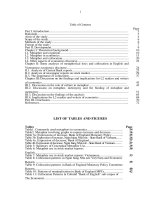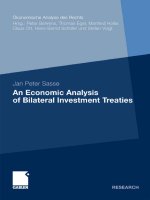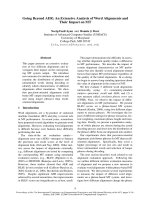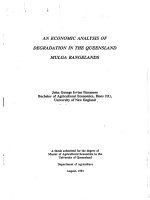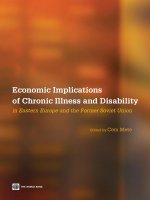An economic analysis of government revenue and expenditure in Nepal
Bạn đang xem bản rút gọn của tài liệu. Xem và tải ngay bản đầy đủ của tài liệu tại đây (422.87 KB, 12 trang )
TRIBHUVAN UNIVERSITY JOURNAL, VOL.: 31, NO.: 1 & 2, JUNE/DEC. 2017
51
AN ECONOMIC ANALYSIS OF GOVERNMENT
REVENUE AND EXPENDITURE IN NEPAL
Krishna Raj Acharya*
ABSTRACT
The government revenue and expenditure are two key words
frequently discussed in economic literature. In the context of Nepal both are
increasing but increase in expenditure is rapid than the increase in revenue.
Government expenditure if not matched with government income, it may
have accompanied with economic evils. Revenue collection if not increased
or managed in time, the amount of public debt will increase more rapidly in
the future. In this connection, the volume of expenditure is increasing year
after year due to the increased role of government in the economy. Revenue
mobilization in fiscal year 2012/13 and 2013/14 hovered around 21 percent
while that in FY 2014/15 was just 13.8 percent. Contribution of revenue to
the total income in FY 2011/12 had remained at 84.85 percent while it grew
to 88.65 percent, 89.86 percent and 90.11 percent respectively in the fiscal
years from 2012/13 2013/14, and 2014/15 respectively. Hence the volume
of public expenditure is increasing rapidly year after year. In FY2012/13
increase in public expenditure was 5.74 percent per annum which reached
to 22.18 per annum in year 2014/15.
Key words: Government revenue, government expenditure, fiscal deficit,
government debt
INTRODUCTION
Government revenue is money received by a government in certain time
period especially in a year from various sources. Especially government
receives their income from tax and non-tax sources. It is also known as
the detail plan of the government income. It is an important tool of the
fiscal policy of the government and is the opposite factor of government
spending. Revenues earned by the government are received from sources
such as taxes levied on the incomes and wealth accumulation of individuals
and corporations and on the goods and services produced, exports and
imports, non-taxable sources such as government-owned corporations'
*
Dr. Acharya is Reader in Economics, Ratna Rajya Laxmi Campus, Department
of Economics, Bhrikuti Mandap, TU.
52
AN ECONOMIC ANALYSIS OF GOVERNMENT REVENUE AND ...
incomes, central bank revenue and capital receipts in the form of external
loans and debts from international financial institutions.
Government expenditure includes all government spending like consumption,
investment, and transfer payments. In national income accounting the
acquisition by governments of goods and services for current use in certain
time period, to directly satisfy the individual or collective wants or needs
of the society or community, is classified as government final consumption
expenditure. Government acquisition of goods and services intended to
create future benefits, such as resilient infrastructure investment or research
spending in various sectors, is categorized as government investment
(government gross capital formation). These two types of government
spending, on final consumption and on gross capital formation, together
constitute one of the major components of gross domestic product of a
nation in the world ( CBS, 2011 a).
Government spending can be financed by government borrowing, seignior
age, or taxes. Changes in government spending are a major component of
fiscal policy used to stabilize the macroeconomic indicators in a nation.
The sources of finance used by the central government are mainly
taxes paid by the public. Government revenue in FY 2015/16 was at Rs.
587.94 billion which was 31.14 percent higher than that of the real income
of FY 2014/15. The public income in FY 2014/15 had stood at to be Rs.
448.33 billion. The revenue of FY 2014/15 was13.12 percent higher than
that of FY 2013/14. Likewise, such revenue of FY 2013/14 was increased
by 18.68 percent to Rs. 396.31 billion. This revenue of FY 2014/15 is 13.12
percent higher than that of FY 2013/14. Likewise, such revenue of FY
2013/14 had increased by 18.68 percent to Rs. 396.31 billion as compared
to its preceding fiscal year (Economic Survey, 2015/16).Of the total budget
of Rs 819.46 billion earmarked for the current fiscal year 2015/16, recurrent
expenditure accounted for 59.1 percent, 25.5 percent allocated for capital
expenditure while 15.4 percent was allotted for fiscal arrangement. In the
previous fiscal year 2014/15, of the gross real expenditure Rs. 531.55
billion, recurrent expenditure was 63.86 percent, capital expenditure was
16.71 percent while 19.43 percent was allotted for fiscal arrangement.
In the developed countries, revenue and expenditure found to be less or
more stable. However in the developing countries, the volume of public
expenditure seems to be very high to compare with revenue. Domestic
sources of revenue in the developing countries are very limited due to the
TRIBHUVAN UNIVERSITY JOURNAL, VOL.: 31, NO.: 1 & 2, JUNE/DEC. 2017
53
poor economic performance. However, the expenditure is increasing due to
expanding activities and role of the governments. As a result, the level of
investment is found to be very low in developing countries. Similarly, there
is lack of investment friendly environment because of economic, social
and political instability. Consequently, per capita income of the people is
limited to be less than $500.Basically, low income leads towards low level
of government expenditure in the developing countries.
OBJECTIVE
The purpose of this article is to find the volume and structures of
government expenditures of Nepal. Even it has some specific objectives
listed as below:
• To identify the change in government income from fiscal year 2011/12
to 2015/16,
• To analyze the government expenditure in the same period, and
• To explore the gap between government revenue and expenditure in
fiscal years 2011/12 to 2015/2016.
METHODOLOGY
The article has used secondary data published by the government of
Nepal from fiscal years 2011/12 to 2015/16.The data is of five fiscal years
2011/12 to 2015/16. Available literature and data are analyzed according to
the objectives. Hence, National Planning commission, Ministry of Finance
and Central Bureau of Statistics are taken into consideration. Similarly,
‘Excel 2007’, ‘SPSS’ and ‘R’ are major tools of analysis.
ANALYSIS AND RESULT
Government income and expenditure both are powerful fiscal
instruments to attain various economic objectives like price stability and
proper allocation of resources. In this connection, government income and
expenditure both are increasing in recent years but increase in expenditure
is more rapid than the increase in government revenue. This has resulted
however found to be long run negative impact on economic development
in a sustainable manner.
Government income from FY 2011/12 to 2015/16
Revenue mobilization of Rs. 475.01 billion with Rs. 427.01 billion
collected from tax revenue and Rs.48 billion from non-tax revenue was
estimated for the fiscal year 2015/16 that means the shares of tax and nontax
54
AN ECONOMIC ANALYSIS OF GOVERNMENT REVENUE AND ...
revenues to the total revenue stood at 87.7 percent and 12.3 percent with
revenue mobilization of Rs.405.86billions in previous fiscal year 2014/15.
The shares of tax and non-tax revenues to the total revenue mobilization
from the fiscal years 2011/12 to 2013/14 remained close to 87 percent and
13 percent respectively while such shares are expected to remain at 89.89
percent and 10.11 percent in current fiscal year 2015/16.
Contribution of goods and services based tax has attained the top
position in the tax revenue collected between FY 2011/12 and the current
fiscal year with about 45 percent share to the total revenue. During this
period, contribution of income, profit and capital gains taxes, and that of
foreign trade based tax to total revenue remained close to 21 percent and 18
percent respectively. The share of property tax in the form of direct tax to
the total revenue collected in fiscal years from 2011/12 to 2014/15 remained
below 2 percent while such share went up to 2.3 percent in previous fiscal
year. Likewise, the property tax amounting Rs. 12.04 billion is expected
to be mobilized in current fiscal year contributing 2.54 percent to the total
revenue. The share of other taxes to the revenue mobilization in the fiscal
years from 2011/12 to 2015/16 has remained about 0.5 percent (Economic
Survey, 2015/16).Details of government income from fiscal year 2011/12 to
2015/16 can be listed as follows (Table 1):
Table 1: Details of Government Income (In Rs 10 Millions)
Fiscal
Year
Tax
Revenue
Non Tax
Revenue
Other
Sources
Total
Government
Income
% Change in
Government
Income
2011/12
21172.2
3265.1
4360.9
28798.3
-----
2012/13
25921.4
3680.6
3790.5
33392.7
15.98
2013/14
31244.1
4417.9
4026.3
39688.4
18.85
2014/15
35595.5
4991.1
4454.5
45041.2
13.48
2015/16*
42701.1
4800.1
11292.9
58794.1
30.53
Source: Financial Controllers General Office and Budght Speech of Current
F/Y 2015/16
Note: * indicates estimated figure
In the Table, there is increase in income annually. In fiscal year
2012/13, increase in income is 15.98 percent and in the last fiscal year it
is projected to be 30.53 percent. In other sources, there are foreign grants,
TRIBHUVAN UNIVERSITY JOURNAL, VOL.: 31, NO.: 1 & 2, JUNE/DEC. 2017
55
principle repayment receipt and irregularities recovery ( Table 1). Of the
total government income estimated for FY 2015/16, revenue was expected
to have a share of 80.80 percent with mobilization of Rs. 475.01 billion,
which was 17.03 percent higher than that of preceding fiscal year 2014/15.
Revenue mobilization in fiscal year 2012/13 and 2013/14 covered around
21 percent while that in FY 2014/15 it was just 13.8 percent. Contribution
of revenue to the total income in FY 2011/12 had remained at 84.85
percent while it grew to 88.65 percent, 89.86 percent and 90.11 percent
in the fiscal years from 2012/13 2013/14, and 2014/15 respectively. It
was an arduous task to mobilize revenue at the desired level owing to
uncomfortable environment that has resulted from devastating earthquake
of April, 2015 and subsequent aftershocks, about five-month long border
obstructions since August last year, low agricultural production due to
adverse climate causing some erosion on demand side of the economy, and
shrunken economic activities (Economic Survey, 2015/16).The graphical
presentation of government income of the fiscal years 2011/12 to 2015/16
was as below:
Graph 1: Government Income from Fiscal Year 2011/12 to 2015/1
Income received by the government was increasing by a linear
trend. The value of R2was 0.98 indicates that there is association between
fiscal year and government income collection.
Government Expenditure from FY 2011/12 to 2015/16
Government expenditure is an important fiscal tool to drive
an economy in a desired direction. If this tool is handled properly and
efficiently, a nation can get rid of various economic problems. In the present
time, the volume of public expenditure is increasing due to widening role of
governments for public welfare schemes.
56
AN ECONOMIC ANALYSIS OF GOVERNMENT REVENUE AND ...
Of the total budget of Rs. 819.46 billion earmarked for the current
fiscal year 2015/16, recurrent expenditure accounted for 59.1 percent, 25.5
percent allocated for capital expenditure while 15.4 percent was allotted
for fiscal arrangements. In the previous fiscal year 2014/15, of the gross
real expenditure Rs. 531.55 billion, recurrent expenditure was 63.86
percent, capital expenditure stood at 16.71 percent while 19.43 percent was
allotted for fiscal arrangement (Economic Survey, 2015/16). The detail of
government expenditure in the fiscal year 2011/12 to 2015/16 was increasing
inconsistently.
Table 2: Details of Government Expenditure
Fiscal
Year
Recurrent
Expenses
Capital
Expenses
Other
Expenses
2011/12
2012/13
2013/14
2014/15
2015/16*
243466
24745.5
30353
33940.7
48426.6
5139.1
5459.8
6669.5
8884.3
20887
4431.7
5658.4
6483.1
10330.4
12631.7
(In Rs 10 Millions)
Total
Government
Expenses
33916.8
35863.8
43505.5
53155.4
81946
%
Change in
Expenses
-----5.74
21.30
22.18
54.16
Source: Financial Controllers General Office and Budght Speech of Current
F/Y 2015/16
Note: * indicates estimated figure
The volume of public expenditure was increasing slightly or
rapidly year after year. In FY2012/13 increase in public expenditure was
5.74 percent per annum but in the fiscal year 2014/15, it was increased by
22.18per cent per annum (Table 2).
Graph 2: Government Expenditures from Fiscal Year 2011/12 to 2015/16
TRIBHUVAN UNIVERSITY JOURNAL, VOL.: 31, NO.: 1 & 2, JUNE/DEC. 2017
57
The volume of public expenditure is increasing year after year.
Hence government expenses were increasing in a linear way whereas
the change in revenue was not increasing to that it might be threat for the
development of the nation. The demand of public expenditure has continued
to grow for expediting the pace of development and construction works and
meeting peoples ‘broad aspirations. The requirement of public expenditure
will certainly escalate in the process of adopting federal governance
system while promulgating new constitution. Maintaining balance among
public expenditure’s demand, need and availability has been a complex
task (Economic Survey, 2013/14).The share of revenue mobilization to
GDP was close to 20 percent. Such ratio generally stands at 35 percent in
countries advancing towards development. The task of mobilizing revenue
in accordance with its viability remains a challenge (Economic Survey,
2015/16).Recurrent expenditure generally occupies one-fourth share in
Nepal’s total public expenditure while the share of capital expenditure shares
was merely 15 percent in total. Though recurrent expenditure complies with
estimation, capital expenditure seems to be remained below par. Despite
fiscal deficit being executed to optimally mobilize public resources, budget
surplus was likely to repeat at the end of the every fiscal year which has
posed challenge to attest the effectiveness of capital expenditure.
Gap between government revenue and expenditure in fiscal year
2011/12 to 2015/2016
Maximum utilization of financial instruments by making the
economy vibrant is a must to achieve sustainable, broad based and high
economic development. Aside from generating revenue potentials, resources
for the large projects that could bring effective changes in development
scenario through the organized, effective and efficient mobilization of
various sources could be guaranteed. There are two string fiscal tools for a
government to stabilize the economy; government income (basically tax)
and government expenditure. There should be balance between these two
fiscal instruments. In Nepal, government expenditure is greater than the
government income so that fiscal gap is negative (Table 3).
58
AN ECONOMIC ANALYSIS OF GOVERNMENT REVENUE AND ...
Table 3: Government Income and Expenditure of Fiscal Year 2011/12 to
2015/16
Fiscal
Year
Total Government
Income
Total Government
Expenses
Fiscal Gap
2011/12
28798.3
33916.8
-5118.5
2012/13
33392.7
35863.8
-2471.1
2013/14
39688.4
43505.5
-3817.1
2014/15
45041.2
53155.4
-8114.2
2015/16*
58794.1
81946
-23151.9
Source: Financial Controllers General Office and Budght Speech of Current
F/Y 2015/16
Note: * indicates estimated figure
There was a gap between government income and expenditure.
Fiscal gap was seemed to be widening year after year. This imbalance
should be corrected in time. Income was increasing ata slow rate that means
public had low capacity to pay tax.
Graph 3: Government Income and Expenditures from Fiscal Year 2011/12
to 2015/16
Public expenditure was increasing in faster pace than that of
government income. Such type of fiscal condition cannot be experienced in
the context of developed countries in the world. The relationship between
government expenditure and income can be analyzed with the help of “R”
software.
TRIBHUVAN UNIVERSITY JOURNAL, VOL.: 31, NO.: 1 & 2, JUNE/DEC. 2017
59
Call:
lm(formula = Total. Government. Expenses ~ Total. Government.
Income,
data = my data)
Residuals:
1
2
3
4
5
4620 -1018 -3771 -2958 3127
Coefficients:
Estimate Std. Error t value Pr(>|t|)
(Intercept)
-1.825e+047.819e+03 -2.334 0.10178
Total.Government.Income1.651e+001.842e-01 8.961 0.00293 **
--Signif. codes: 0 ‘***’ 0.001 ‘**’ 0.01 ‘*’ 0.05 ‘.’ 0.1 ‘ ’ 1
Residual standard error: 4287 on 3 degrees of freedom
Multiple R-squared: 0.964,
Adjusted R-squared: 0.952
F-statistic: 80.3 on 1 and 3 DF, p-value: 0.002933
Source: Based on data analysis through R software
This analysis helps to draw a conclusion that there was an
association between government expenditure and government income.
Government expenditure was assumed to be dependent in this analysis and
income was an independent variables. One rupee increase in government
was accompanied with 96 paisa increased in the government expenditure.
When same data was analyzed through Excel 2007 software:
0.963986
0.951981
4286.638
5
R Square
Adjusted R Square
Standard Error
Observations
3
4
t a n d a r d t Stat
Coefficients S
Error
-18248.9
1.650986
Total
Intercept
Total Government
Income
Source: Based on data (Excel 2007 software)
0.18424
7818.849
1.53E+09
55125804
8.961038
-2.33396
18375268
1.48E+09
Residual
1.48E+09
1
MS
Regression
SS
df
ANOVA
0.981828
Multiple R
Regression Statistics
0.002933
0.10178
P-value
80.3002
F
1.06465
-43132
Lower 95%
0.002933
Significance F
Table 3.1: Regression Analysis of Government Income and Expenditure
2.237321
6634.16
Upper 95%
1.06465
-43132
Lower
95.0%
2.237321
6634.16
Upper
95.0%
60
AN ECONOMIC ANALYSIS OF GOVERNMENT REVENUE AND ...
TRIBHUVAN UNIVERSITY JOURNAL, VOL.: 31, NO.: 1 & 2, JUNE/DEC. 2017
61
There was a close association between government expenditure
and government income. The value of R2 is 0.96 and the value of p= 0.0029
(p value, Table 3.1).
Causes of low government revenue and revenue gap
Tax collection is a main source of government income however
it was limited due to very narrow tax base. Tax payments tend to be
concentrated only among a few taxpayers in South Asia. In India only 3
percent of the population pays personal income tax, with the figure even
lower at about 1 percent in Bangladesh, Nepal, and Pakistan. A plethora
of exemptions also exist, which have made tax systems more complex and
may have contributed to the emergence of vested interests to resist further
reforms.
Similarly, south Asian countries typically rank low on the common
yardsticks of efficient tax administration. For instance, time spent preparing
and paying taxes for a typical firm in South Asia was more than 300 hours,
compared to 200 hours in East Asia and 175 hours in advanced countries
(Shaw, 1889).
In this connection, previous research has shown that higher shares
of agriculture and service sectors in GDP are negatively correlated with
revenue to GDP ratios in developing countries, as was poor governance. This
was particularly relevant for larger South Asian Countries, where agriculture
has historically been under-taxed, while service sectors are also relatively
large. Other factors that might impinge on low revenue mobilization include
low literacy rates, large rural populations, large informal economies, and
poor governance. In addition, the financial sector is underdeveloped in
South Asian Countries with the implication that financial transactions
occur in cash, abetting tax evasion. Indeed countries that have succeeded
in increasing the size of their financial sector in the past decade (Bhutan,
Maldives, and Nepal) have also been managed to increase their tax ratios.
Gap between public revenue and expenditure is a fiscal issue that basically
chronic in least developed countries in the world. Revenue administration
should be strong and broad based so that there is less chances of revenue
leakage. Tax base and rate should be reformed in such a way that revenue
should be maximum accompanied with no increase in gap between rich
and poor. Government expenditure should be prioritized in the areas where
capital output ratio at least equal (CBS, 2011). Development activities
should be directed towards productive capacity enhancement rather than the
62
AN ECONOMIC ANALYSIS OF GOVERNMENT REVENUE AND ...
interest of donor agencies. The government should be wise for the proper,
effective and efficient utilization of scarce resources of underdeveloped
countries in the world. Lowering the gap could have a positive effect in the
national economy for low dependency on foreign sources. It also is useful
to accelerate the pace of domestic capital formation and ultimately higher,
sustainable and broad-based growth rate.
CONCLUSION
Government income estimated for FY 2015/16, revenue was
expected to have a share of 80.80 percent with mobilization of Rs. 475.01
billion, which was 17.03 percent higher than that of preceding fiscal
year 2014/15. Revenue mobilization in fiscal year 2012/13 and 2013/14
hovered around 21 percent while that in FY 2014/15 was just 13.8 percent.
Contribution of revenue to the total income in FY 2011/12 had remained at
84.85 percent while it was 88.65 percent, 89.86 percent and 90.11 percent
respectively in the fiscal years from 2012/13 2013/14, and 2014/15. Hence
the volume of public expenditure was increasing rapidly year after year.
In the FY2012/13 the increment in public expenditure was 5.74 percent
per annum which reached to 22.18 per annum in the FY 2014/15. There is
a gap between government income and expenditure. Fiscal gap has been
widening year after year. This imbalance should be corrected properly in
time. Government revenue is increasing at slower rate. Hence, the taxable
capacity of the nation should be strengthen.
WORKS CITED
CBS, (2011a). Poverty in Nepal. Kathmandu: National Planning
Commission, Government of Nepal.
- - - (2011b). Nepal living standard survey, vol I &2, Kathmandu: National
Planning Commission, Government of Nepal.
Ministry of Finance (2012). Economic survey. Kathmandu: Government
of Nepal.
- - - (2013). Economic survey. Kathmandu: Government of Nepal.
- - - (2014). Economic survey. Kathmandu: Government of Nepal.
- - - (2015). Economic survey. Kathmandu: Government of Nepal.
- - - (2016). Economic survey. Kathmandu: Government of Nepal.
- - - (2015, 2016). Budget speech. Kathmandu: Government of Nepal.
Shaw, A. (1889). Municipal government in Britain. Political Science
Quarterly, 4(2), pp.197-229.
